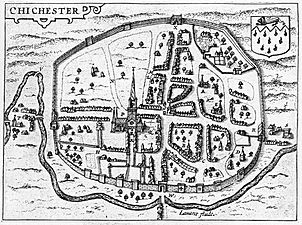Siege of Chichester facts for kids
Quick facts for kids Siege of Chichester |
|||||||
|---|---|---|---|---|---|---|---|
| Part of the First English Civil War | |||||||
 Chichester in 1610 – 32 years before the siege |
|||||||
|
|||||||
| Belligerents | |||||||
| Commanders and leaders | |||||||
| John Morley Edward Ford |
William Waller Michael Livesey |
||||||
| Strength | |||||||
| Unknown | Unknown | ||||||
| Casualties and losses | |||||||
| Low | Low | ||||||
The Siege of Chichester was an important event during the First English Civil War. It was a battle where the Parliament's army, known as the Parliamentarians, won against the King's army, called the Royalists.
The Parliamentarian forces were led by Colonel William Waller. Their goal was to take control of southern England for Parliament. The siege lasted for five days. It ended when the Royalist soldiers defending Chichester gave up. Even though the Royalists surrendered, Waller's troops still damaged and disrespected Chichester Cathedral.
Why the Siege Happened
Before the war started, on August 16, 1642, a man named William Cawley made a big statement. He was a Member of Parliament for Chichester. He said that Chichester would support Parliament, not King Charles I. This statement was called the 'Valiant Resolution'.
However, this was not an official decision for the whole city. Some Royalists in Chichester wanted the city to support the King. The Mayor of Chichester, Robert Exton, then asked all men to join the King's army. This was called a Commission of Array.
Later, the new Mayor, William Bartholomew, got cannons and soldiers. These came from Portsmouth and the local Sussex army. In November, the Governor of Portsmouth sent seven guns and ten barrels of gunpowder. Finally, William Morley and Edward Ford gathered a small army. They forced William Cawley and his Parliament supporters out of Chichester on November 15.
The Battle for Chichester
Colonel Waller's Parliamentarian army reached Chichester on December 21. They were joined by cavalry (soldiers on horseback) led by Sir Michael Livesey. The Royalists sent a small group of soldiers out to fight them. But they were pushed back and had to return inside the city walls.
Once the area was safe, Waller started setting up his large cannons. At the same time, he asked the Royalist soldiers inside the city to give up. The next morning, the Royalists refused his offer. So, Waller began to fire his cannons at the city.
For the next few days, Waller kept firing his cannons. He moved them closer and closer to the city walls. He was gaining more control of the area outside the city. Just as Waller was getting ready to attack the walls from three different sides, the Royalists asked to talk about surrendering again.
They reached an agreement, and the Royalist soldiers gave up on December 27. Because the Royalist leader, Morley, surrendered the city, it was not completely destroyed like some other places. However, Waller still let his soldiers damage and disrespect the city's cathedral.

